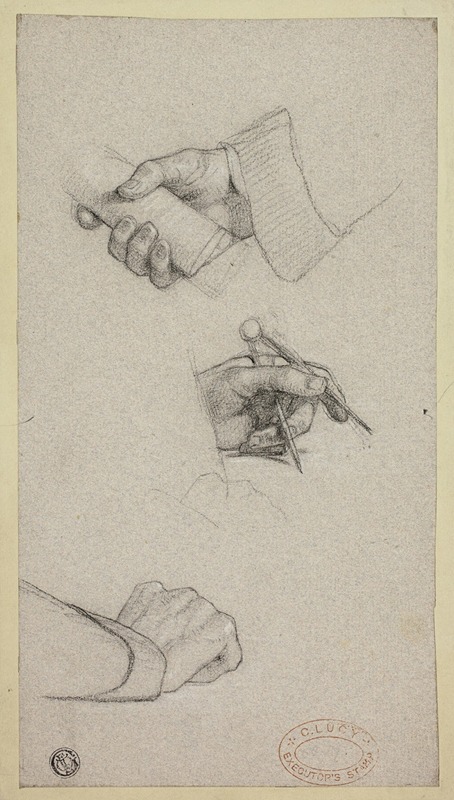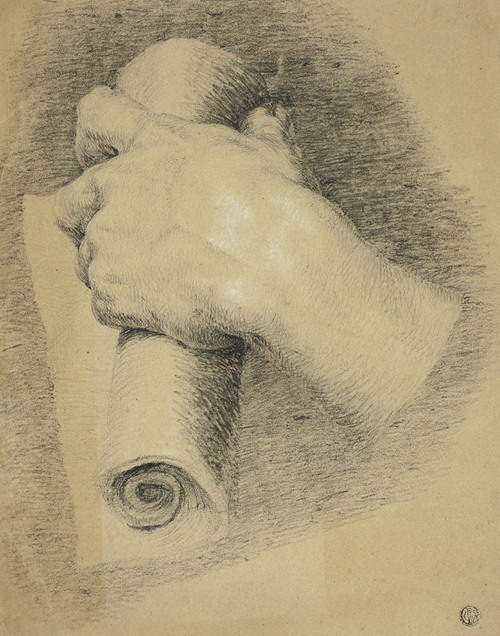

Charles Lucy was a British artist during the Victorian era who, while he was a talented portraitist, mainly focused on the history painting genre and whose work was mainly exhibited at the Royal Academy of Arts in London, England.
Charles Lucy was born at Norton Canon, Herefordshire in England in July 1814 and according to family records, he was his parent's first born child. His family descended from the Lucys of Charlecote, Warwickshire, who afterwards settled in Worcestershire.
Charles Lucy had a natural affinity for painting. He spent his spare time painting anything he could get his hands on. As a child, he was even known to prepare his own colours and manufacture his own brushes. His memoriam in The Hereford Times noted that "his natural bent from a very early age was towards painting, and he began to practice it without instruction, until aided by friends, he devoted his life to art. With that view he decided to go to London to pursue his studies." At the early age of fifteen he was apprenticed to his maternal uncle, Price Griffiths, who was a chemist in Hereford, but he was so passionate about art that he would sneak a lantern into his room, so he could paint all night long.
He first studied at the Royal Academy of Arts in London, then in Paris under Paul Delaroche at the École des Beaux-Arts. In 1838, he returned to London to attend the Royal Academy of Arts as a student. Thereafter, Mr. Lucy spent two years studying paintings by Old Master in Paris and The Hague for a private patron. He also "pursued his studies in the Louvre and other great public galleries."
The "self-taught" young Mr. Lucy "commenced his career as a painter of portraits, his father being one of the earliest of his productions." According to family records, "he soon left his uncle's establishment, and became an earnest in the art in which he so ably succeeded; and for several years travelled in Belgium, France, and the Netherlands, and returned to England about the year 1836." Family writings revealed that "he then competed with Mr. Frost (who was also self-taught) for the gold medal of The Royal Academy of Arts, with his painting Prometheus Chained, which is now in the possession of the Philosophical Society at Hereford." According to family papers, "Mr. Frost obtained the prize, his picture being the more finished than that of Mr. Lucy, but the latter was generally looked upon as the bolder and more artistic work."
He is best known for his painting of The Landing of the Pilgrim Fathers, which is displayed in the National Heritage Museum in Lexington, Massachusetts, in the United States of America. His other notable work include his engravings of Oliver Cromwell and a painting called, The Burial of King Charles the First, in St. George's Chapel of Windsor Castle, which was sold by the London auction house, Bonhams, in October 11, 2006.
For sixteen years Mr. Lucy took up his residence in Paris, Barbizon and Fontainebleau, where he reared his children with his wife, Ann. He continued to maintain his connection with Hereford, of which, according to the Freeman's Roll, he was admitted a freeman on July 29, 1841, thereby bestowing Mr. Lucy with certain rights and privileges within his native city. But it was while he was in France that he executed several of his greatest works, before he returned to London, where he resided until his death.
Charles Lucy "painted historical subjects and some portraits, which were frequently engraved." He exhibited his first historical painting, "The Interview between Milton and Galileo," in 1840 at the Royal Academy of Arts in London. After his first historical painting, "The Interview between Milton and Galileo," was hung in 1840" at the Royal Academy of Arts in London, Mr. Lucy divided his time between England and France. He lived in Barbizon for 16 years, but rather than joining the landscape painters there, he chose to continue is focus on significant scenes in British history. In 1847, he painted “Embarkation of the Pilgrim Fathers in the Mayflower," (later retitled: "Departure of the Pilgrims from Delft Haven"), which won him a prize bestowed by Prince Albert at the prestigious Westminster Hall competition in London in the same year. It was also one of the first pieces to bring Mr. Lucy attention on the east side of the English Channel. It would not be long before, "he was a regular contributor to the fresco competitions for the New Palace of Westminster." In 1848, it too was exhibited it at the Royal Academy of Arts in London. Family records show that in 1838 Mr. Lucy "receiv[ed] considerable distinction and much practice as a rising artist [after he] obtained the Two Hundred Guineas Prize at the Exhibition of Cartoons in Westminster Hall, for his painting of The Pilgrim Fathers Embarking for America, which [resulted] in the late Sir Robert Peel taking great notice of him."
Of all his work, Mr. Lucy is best known for his 1848 painting, The Landing of the Pilgrim Fathers A.D. 1620, which is currently displayed in the National Heritage Museum in Lexington, Massachusetts, in the United States of America. Thereafter, Mr. Lucy served as the elected chairman of the committee of the New British Institution since its foundation in 1869 and "for many years was instructor at a drawing and design school in Camden Town, which he founded along with Thomas Seddon, Cave Thomas and one or two others.

